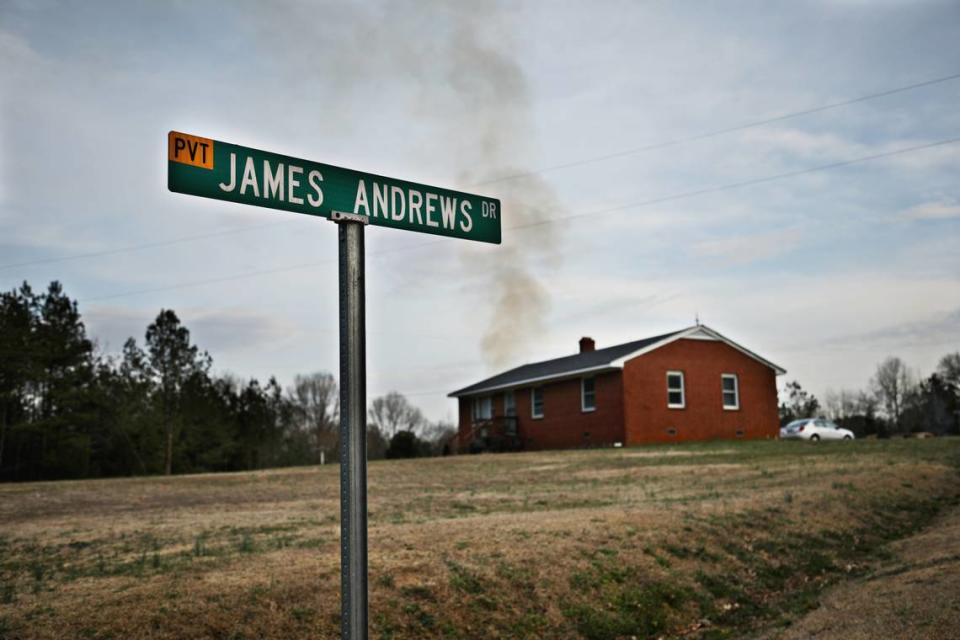New rap video sums up USDA discrimination, broken promises to Black and Indian farmers
- Oops!Something went wrong.Please try again later.
Just as the nation celebrated Thanksgiving and the bounty of the land, activist John Boyd and rapper KJ “Skippa Mak” Marley have released a music-video reminder that the U.S. government still has not made good on its promises to Black and Native American farmers.
Boyd and Marley’s “The Land,” released on Youtube, Spotify and Apple Music, lyrically summarizes the decades-long fight to get the U.S. Department of Agriculture to stop discriminating against non-white farmers in its lending practices.
Boyd, a fourth-generation farmer in Mecklenberg County, Va., is founder and president of the National Black Farmers Association and has fought for decades in court and before Congress to force the USDA to stop denying non-white farmers access to the programs that have helped white growers keep and expand their operations.
“I don’t mind telling you, I have been struggling to connect with the younger generation,” Boyd said in a phone interview. “We need to get them engaged on issues about farming and agribusiness. We’re hoping that music and rapping will get some of them intrigued, and maybe they’ll listen to the lyrics and learn about what’s going on.”
‘Where is our money?’
The video begins with an image of a pair of black hands clapping off the dust of a farm field and Boyd introducing himself.
“Black farmers were promised $5 billion, and we didn’t get it,” he says. “Where is our money?”
His words are interspersed in the video with Marley’s lyrical interludes. Boyd met Marley and others in his family several years ago at a farming conference; the family operates Marley Coffee. Marley is the grandson of reggae singer Bob Marley.

“They say he who controls the land controls the man, and if you ask me they still owe me land,” Marley says in the video.
“Five billion dollar promises, you owe me some cash. Instead I got spit on, my applications thrown in the trash.
“I been fighting my whole life, only the strongest will last. And we won’t stop until they get it right, I promise you that.”
Money promised but halted
Earlier this year, USDA Secretary Thomas Vilsak acknowledged that the USDA’s discriminatory practices had prevented “numerous African-Americans, among other people of color, from fully realizing the same level of prosperity and success as their white counterparts. Unfortunately, the racism that resulted in the precipitous decline of Black Farmers over the last century has also been evidenced among other groups of socially disadvantaged farmers.”
In the American Rescue Plan approved in March, Congress appropriated $5 billion for what the USDA calls “socially disadvantaged” farmers. About $4 billion of the funds would be used to forgive outstanding debt and the remaining $1 billion for training, outreach, education, technical assistance and grants.
The package provides $5 billion for socially disadvantaged farmers of color, including $4 billion for the forgiveness of outstanding debt and $1 billion for training, outreach, education, technical assistance and grants.
But some Republican lawmakers had expressed concern about the debt-relief program being targeted at people of color.
With the passage of the law, the USDA began to send information and applications to farmers who might qualify for the assistance based on the types of loans they had. But before any money could be disbursed, white farmers in Wisconsin and Florida sued in federal court to prevent the debt relief, calling it reverse discrimination. Similar suits have since been filed in other states.
Preliminary injunctions issued by judges in the Wisconsin and Florida cases have temporarily halted the processing of payments, and the USDA has told farmers they can continue to make payments on loans that might qualify for the relief but that it will not take action against them if they don’t.
‘More of the same’
Boyd said thousands of farmers might qualify for the relief.
Boyd and the courts have said that the USDA made accommodations for struggling white farmers who owed money while denying the same aid to people of color. That discrimination has led to a loss of millions of acres of farmland once held by Blacks, Native Americans and other non-whites dating back generations, Boyd says.
In the USDA’s 2017 Census of Agriculture, North Carolina reported 1,435 farms on which 1,699 Black farmers were the principal producers. Black owners held 3% of the 46,418 farms in the state.
Blacks make up 22% of the state’s population.
Boyd said he was frustrated over the lawsuits that stopped the debt-relief program and said it’s a reach to see the help as reverse discrimination when its stated purpose is to make up for generations of systemic disparities.
The USDA should have done more to get the money flowing, he said, so at least some farmers would have received help before the injunctions took effect. He had hoped that Congress would put administration of the debt-relief under a third party, rather than letting the USDA oversee the remedying of its own mistakes.
“When white farmers got debt relief under President Trump,” Boyd said, “he signed it into law and they got money in their bank accounts within days. This is just more of the same in terms of the ways we have seen the USDA treat Black farmers.”

